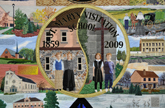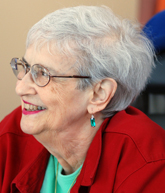In celebration of the 150th anniversary of St. Mary Visitation School and its relationship with the School Sisters of Notre Dame, Riggio, a quilt artist, created an elaborate and unique quilt chronicling the school’s history.

Eleven years in the making, the 57-inch wide by 75-inch long quilt centers on the origins of the School Sisters of Notre Dame located on Watertown Plank Road and the way their lives are woven into the families of a century and a half of students.
“The famous story, depicted on the quilt, is that Mother Caroline’s horse simply stopped on the old plank road and wouldn’t go any further,” explained Kathy Smith, parishioner and school volunteer. “So she took it as a sign from God that this was where she should build. The SSND on Watertown Plank was built on that spot and since the mission of the SSND is education, they began a school.”
While the parish and the sisters celebrated their 150th anniversaries a few years ago, the history of the school is depicted on the quilt, along with written pieces that accompany the pictures.
When the parish senior citizen group organized a showing of Riggio’s quilts in 1997, Smith and the late Fr. Dan Pakenham were impressed by the quality and intricacy of her work. Both were looking for a means to honor the retiring Sr. Betty Uchytil, the last principal from the School Sisters of Notre Dame religious order.
“I went to Fr. Dan and asked about commissioning a quilt,” said Smith. “He gave the go-ahead as long as I was willing to find the funding. With Suzanne’s help, we covered the cost with a combination of private gifts and grants that she applied for and received.”
A long time supporter of the fine arts, Fr. Pakenham anticipated the quilt as a lasting and appropriate gift to honor Sr. Uchytil, while commemorating the 150th anniversary of the school.
Throughout the 11-year period, much of Riggio’s efforts were consumed with research, alternated with sketching the design, piecing and sewing. In the midst of the project, she endured several surgeries that left her paralyzed from the waist down, and required many physical therapy sessions. Despite her ailments, she continued to work on the heirloom.
According to Riggio, she spent the early years reading, photographing, and speaking with members of St. Mary Parish.
“This allowed me to find the various elements that were the heart and soul of St. Mary’s School,” she said. “I made lists. Then I sketched my layout, which included these many elements, and ran them by Fr. Dan, who approved them.”
Comprised of a variety of fabrics, such as cottons, silks, polyesters, nylon, tulle, Ultrasuede, prismatic foil, and computer printout fabric, Riggio also used embroidery and silk threads, braids, beads, glitter, lamé, sheers, ink, cords, gold jewelry, and oboe string.
“The oboe string was used for the shoe strings on the tennis shoes of the 2009 children depicted on the quilt,” she said. “I used the prismatic foil for the stained glass. I had seen it demonstrated at a meeting of the Professional Art Quilters Alliance in Chicago and had obtained a sample of silver color. The vendor was from Maryland, but was in Japan at the time I went looking for the material, so I e-mailed her and she sent me a packet of every color she had.”

To ensure historical accuracy, Riggio researched the school’s history and donated much of her work to the Elm Grove library because so much of the SSND’s and St. Mary’s history are integral to the village.
“All the land that comprises the village grounds, including the park, police department, fire department, and library, originally belonged to the SSND, who donated it to the village,” said Smith. “As part of the grant from the Wisconsin Arts Board, Suzanne was required to teach students at St. Mary about the history and how she was going to depict it.”
Because she was not a native of Elm Grove, and only joined the parish in 1995, after moving from West Virginia, Riggio used videotapes, books, old photos, family histories, new photos and interviews to complete the research for her design.
Creating the rose window stained glass design in the back of the current church was a challenge, as organ pipes cover most of the window. To piece the design together, Riggio took photos of the window in between the organ pipes, as well as from the outside during the night, when the lights in the church were on.
“I wrote to Conrad Schmidt Studios who were able to provide me with two-thirds of the cartoon of the window,” she said. “When the window was done, I brought it to St. Mary to show Fr. Dan and to the classes at school and I was on my way!”
From a distance, the quilt depicts various stained glass windows, maps of the area, changing styles of the church and school buildings, and school children dressed as they were 150 years ago and now. Up close, the detail is impressive and surprising to the viewer, and Riggio likes it that way.
“I show Watertown Plank Road through Elm Grove when it really was a plank road between Milwaukee and Watertown,” she said. “Picket fencing is made of 3-D strops of Ultrasuede with flowers in the yard peeking through. The white church on the triangle has lightening rods topped by glass balls – teeny beads, actually.”
The rosaries on two nuns pictured on the quilt are from pieces of jewelry, and she used an actual 1859 dress provided by the SSND’s archivist, Sr. Suzanne Renee, as the model for the girl’s 1859 garment.
“The map of Elm Grove in the lower right shows not only the real estate transactions through the years, but also the location of the first Catholic church, St. Ambrose, in the area,” said Riggio. “The Milwaukee map in the upper right shows the block where the first convent of the School Sisters of Notre Dame was. In the image of the school complex before remodeling, there is the blue awning printed with St. Mary School.”
Reactions from onlookers have been overwhelming. Most cannot believe that among the many details included in the design, Riggio managed to capture the first convent and old milk house school with such detail as to include the fieldstone base and grapevine that is still thriving. The 1913 school depicts one of the two outhouses, and the four corners of the quilt show monstrances.
“I paid attention to the skies and vegetation, especially the flowers, and all the seasons are represented,” said Riggio, adding, “The four children shown in the center are from the class of 2009, I took their pictures one early morning when they were in the first grade. They are from left: Jack Ordman, Mary Kate Berens, Brigitte Potter, and Joseph Puchner. All are descendants of pioneer families at St. Mary Visitation.”
While she has created other heirloom quilts for her children, this project was the most challenging of her quilting career.
“Art quilting is my third career. My second career was in music. I was the dean of music at the University of Charleston and principal horn in the West Virginia Symphony,” explained Riggio. “I began quilting in 1990 after I retired. I’ve made 130 quilts, some of which are commissions. My husband Donald and I have five children – and they were my first career.”
The only drawback to the quilt is that Fr. Pakenham did not live to see the completed project, but prior to his death, he ensured that a double sided glass case was built that would protect the heirloom.
“We can’t express how sad we are that he isn’t here to see it finally completed,” said Smith. “He did see it almost completed shortly before he passed away.”
